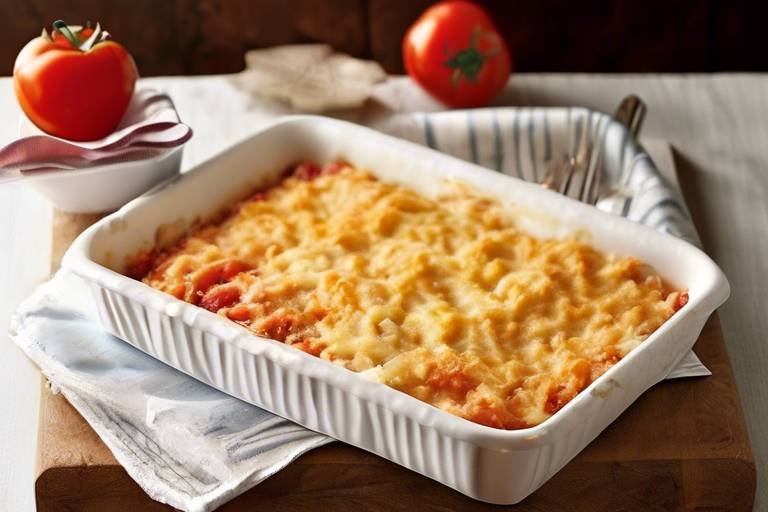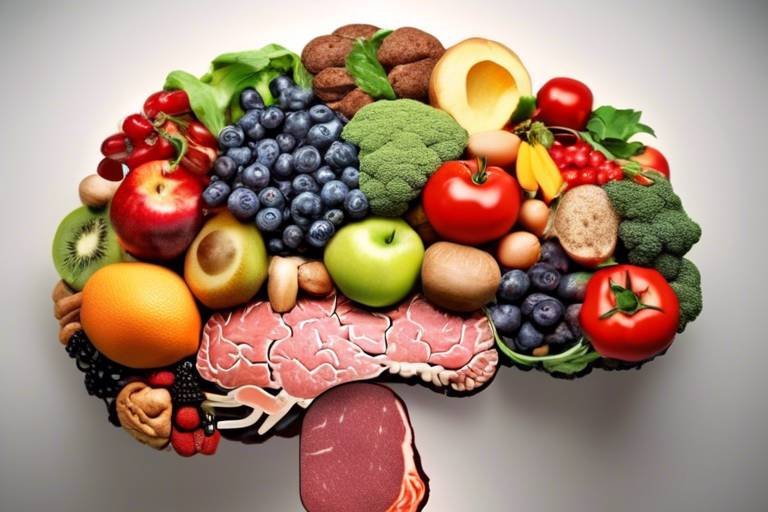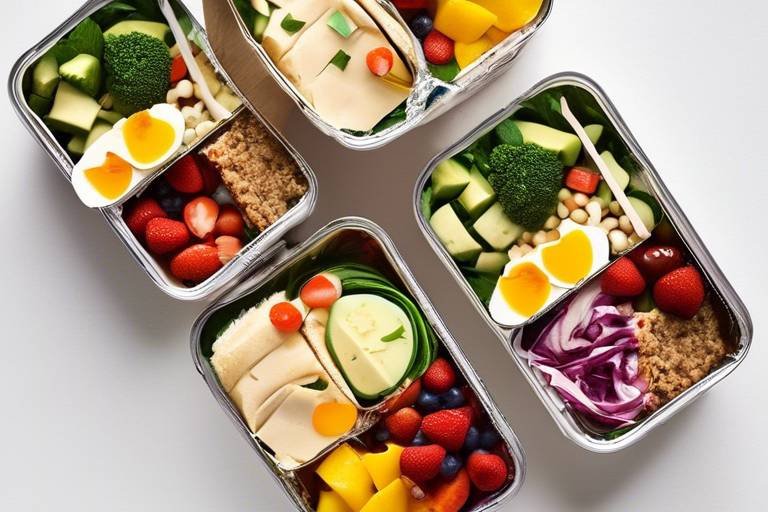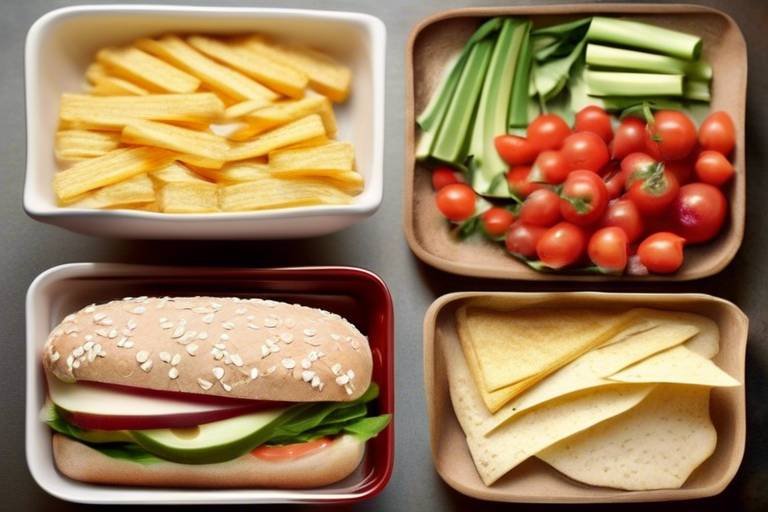The Nutritional Benefits of Eating as a Family
Exploring the importance of family meals, this article highlights the nutritional advantages, emotional connections, and overall well-being derived from shared dining experiences. Discover how family meals can enhance health and relationships.
Eating together as a family often leads to healthier meal choices, promoting a balanced diet rich in essential nutrients. When families gather around the dinner table, they tend to opt for more wholesome options, steering clear of processed foods. This is largely because shared meals encourage the preparation of fresh, nutrient-dense ingredients. Imagine the vibrant colors of a salad bursting with greens, reds, and yellows, all prepared together. It’s not just about the food; it’s about the experience. Families that dine together are more likely to include a variety of food groups in their meals, which can lead to improved dietary quality.
Research has shown that children who regularly eat with their families are more likely to consume fruits and vegetables. They also tend to have better overall nutrition, which can be attributed to the positive influence of shared meals. The act of sitting down together allows for discussions about food choices, making it easier to incorporate healthier options. In fact, a study found that family meals are associated with higher intakes of essential vitamins and minerals, which are crucial for growth and development.
Family meals provide an opportunity for connection and communication. When everyone gathers around the table, it creates a unique space for sharing stories, laughter, and even challenges faced during the day. This time spent together fosters relationships and creates lasting memories, contributing to a supportive family environment. Think of it as a daily ritual where everyone has a chance to be heard and valued. This emotional connection is vital for maintaining healthy family dynamics.
Establishing regular meal times encourages consistency and stability within the family. When families commit to dining together, it sets a routine that can be comforting, especially for children. Routines provide a sense of security and predictability, which can help reduce anxiety. Imagine the anticipation of a Friday night pizza night or Sunday family brunch; these traditions can become cherished moments that everyone looks forward to. This consistency not only promotes healthier eating habits but also strengthens family cohesion.
Involving family members in meal preparation can enhance their interest in healthy eating. When kids help wash vegetables or stir the pot, they become more engaged with the food they are consuming. This hands-on experience can lead to better food choices and increased enthusiasm for trying new dishes. It's like turning the kitchen into a mini cooking show where everyone contributes. The more involved they are, the more likely they are to develop a positive attitude toward healthy foods.
Dividing meal preparation tasks among family members fosters teamwork and responsibility. When everyone pitches in, it not only lightens the load for one person but also creates a sense of ownership over the meal. This collaborative effort can lead to improved overall meal quality. For instance, one person might chop vegetables while another sets the table, making the experience more enjoyable and less stressful. By sharing these responsibilities, families can build stronger dynamics and encourage a sense of community within the household.
Regular family meals have been linked to better mental health outcomes. The simple act of sharing a meal can reduce stress and promote emotional well-being among family members. It’s a time to unwind and connect, which can be particularly beneficial in today’s fast-paced world. Picture this: after a long day, sitting down to a warm meal surrounded by loved ones can feel like a comforting hug. This atmosphere of support can lead to decreased feelings of isolation and anxiety, making family meals a powerful tool for mental health.
Family meals provide an ideal setting for teaching children about nutrition and healthy eating behaviors. Parents can use this time to discuss the importance of various food groups, portion sizes, and the benefits of eating whole foods. It’s more than just a meal; it’s an educational experience. By incorporating discussions about where food comes from and why it matters, parents can instill lifelong healthy habits in younger generations. Think of it as planting seeds of knowledge that will grow into a lifetime of healthy choices.
Parents can model healthy eating behaviors during family meals. Children are like sponges, absorbing not just what is said but also what is done. When they see their parents making nutritious choices and enjoying a variety of foods, they are more likely to follow suit. This influence is crucial in shaping their attitudes towards nutrition. It’s like being a role model in the kitchen, where actions speak louder than words. By demonstrating a balanced approach to eating, parents can guide their children toward making healthier choices.
Family meals offer a chance to introduce diverse cuisines and cultural practices. Sharing different food traditions can enhance appreciation for various cultures and broaden culinary horizons. Imagine a night dedicated to Italian cuisine, complete with homemade pasta, or a taco night where everyone customizes their own meal. These experiences not only make mealtime exciting but also serve as a gateway to learning about different cultures. It’s a delicious way to celebrate diversity while creating memorable family moments.
- What are the benefits of eating together as a family? Eating together promotes healthier eating habits, strengthens family bonds, and improves mental health.
- How can I encourage my family to eat together more often? Establish regular meal times, create fun traditions, and involve everyone in meal preparation.
- What if my family has different dietary preferences? Use family meals as an opportunity to explore diverse cuisines and accommodate different dietary needs.

Improved Nutritional Intake
When families come together for meals, magic happens in terms of nutrition. Eating as a family often leads to healthier choices, which is a big win for everyone involved. Imagine this: you're sitting around the dinner table, sharing stories about your day while enjoying a colorful plate filled with vegetables, lean proteins, and whole grains. It's not just about filling your stomach; it’s about fueling your body with the right nutrients. Research shows that families who eat together tend to consume more fruits and vegetables, which are packed with essential vitamins and minerals that our bodies crave.
One of the reasons why family meals are so effective at improving nutritional intake is the variety they often bring to the table. When you have multiple family members involved in meal planning and preparation, you're more likely to explore different food options. This means not only are you enjoying your favorite dishes, but you're also trying new ingredients and flavors that you might not have considered otherwise. For instance, introducing a new vegetable or a different grain can open up a whole new world of nutrition. Think of it as a culinary adventure where everyone contributes to the journey!
Additionally, family meals can help establish healthier eating patterns. When everyone sits down together, there’s a natural tendency to eat mindfully. Instead of munching mindlessly in front of the TV or grabbing fast food on the go, family meals encourage us to slow down and savor our food. This practice can lead to better digestion and a greater awareness of what we’re consuming. Plus, it’s easier to stick to portion control when you're sharing a meal with others.
Here’s a quick look at some of the nutritional benefits of family meals:
- Increased fruit and vegetable consumption: Families that dine together often include a variety of produce in their meals.
- Better meal planning: When families plan meals together, they’re more likely to include balanced options.
- Mindful eating habits: Shared meals promote awareness of food choices and portion sizes.
Moreover, the emotional aspect of eating together shouldn't be overlooked. When families gather for meals, they create an environment that encourages discussions about food and nutrition. Parents can seize this opportunity to educate their children about the benefits of eating healthy. By explaining the importance of nutrients and how they help our bodies function, parents can instill a sense of curiosity and responsibility in their children regarding their food choices. It’s like planting seeds of knowledge that will grow into lifelong healthy habits.
In summary, family meals are not just about satisfying hunger; they are a powerful tool for improving nutritional intake. By coming together to share food, families can enhance their diets, foster healthy eating habits, and create lasting memories, all while ensuring that everyone is getting the nutrients they need to thrive.

Strengthened Family Bonds
Gathering around the dining table is more than just a way to fill our stomachs; it’s a golden opportunity to nurture relationships and create lasting memories. When families come together for meals, it fosters a sense of belonging and unity that is hard to replicate elsewhere. Imagine the laughter echoing through the room, the stories shared, and the bonds strengthened with each bite. These moments are crucial in building a supportive family environment where everyone feels valued and connected.
During family meals, we engage in meaningful conversations that allow us to share our thoughts, dreams, and even our struggles. This open line of communication is vital for understanding one another better. For instance, a simple question like, “How was your day?” can lead to deeper discussions about personal challenges or achievements. It’s in these moments that we learn to empathize with each other, creating a strong foundation of trust and support.
Moreover, the routine of family meals can cultivate a sense of stability, especially for children. Knowing that dinner time is a time for family helps kids feel secure and loved. It’s like a comforting ritual that they can rely on amidst the chaos of life. Establishing this routine can be as simple as dedicating a few nights a week to sit down together, without distractions from phones or television. This intentional practice not only strengthens family ties but also promotes a healthier lifestyle.
Involving everyone in the meal preparation can further enhance these bonds. When family members collaborate in the kitchen, it transforms cooking from a mundane task into a fun and engaging activity. Whether it’s chopping vegetables, stirring sauces, or setting the table, each person plays a role that contributes to the overall experience. This teamwork fosters a sense of accomplishment and pride, as everyone can take credit for the delicious meal that they have created together.
Additionally, sharing responsibilities during meal times teaches valuable lessons about teamwork and accountability. When each member has a designated task, it not only lightens the load but also promotes a sense of ownership. Children learn that contributing to family meals is important, and they gain skills that will serve them well into adulthood. It’s a win-win situation that enhances both the quality of the meal and the dynamics of the family unit.
Ultimately, the act of sharing meals together creates a tapestry of experiences that weave family members closer together. The memories made at the dinner table—whether it’s a holiday feast or a simple weeknight dinner—become cherished stories that are passed down through generations. So, the next time you sit down for a meal, remember that you’re not just nourishing your body; you’re also strengthening the bonds that hold your family together.

Creating a Routine
Establishing regular meal times is like setting the stage for a family performance—each member plays a vital role, and the rhythm of the routine brings harmony to the household. When families commit to eating together at specific times, it fosters a sense of consistency and stability. Just think about it: how often do you find yourself rushing through meals or grabbing something on the go? By creating a routine, you not only prioritize family time but also encourage healthier eating habits. It’s like planting a garden; the more you nurture it with care and attention, the more it flourishes.
Moreover, having designated meal times can significantly reduce the chaos of daily life. Imagine coming home from a long day, knowing that dinner is ready, and everyone is gathered around the table. This routine not only enhances the quality of the meals but also improves communication among family members. During these shared moments, families can discuss their day, share stories, and even tackle any issues that may arise, creating a supportive environment where everyone feels valued.
To make this routine stick, consider the following tips:
- Set a Schedule: Choose specific days and times for family meals that work for everyone. Consistency is key!
- Make it Fun: Create themed dinners or try new recipes together to keep everyone engaged and excited about meal times.
- Limit Distractions: Turn off the TV and put away devices during meals to encourage conversation and connection.
Incorporating these elements into your family meals can transform them into cherished rituals. Just like a favorite family tradition, having regular meal times creates a sense of belonging and shared purpose. It’s not just about the food; it’s about the experiences and memories that are built around the table. So, why not take the plunge and start establishing a family meal routine today? Your family will not only eat better but will also grow closer in the process.
1. How often should we have family meals?
It's ideal to aim for at least three to four family meals a week, but the more, the better! The key is to find a balance that works for your family's schedule.
2. What if my family has different schedules?
Try to coordinate meal times that accommodate everyone as much as possible. Even if it’s just one meal a week, it can still make a significant difference.
3. How can I encourage my kids to participate in family meals?
Involve them in meal planning and preparation. Let them choose a recipe or help set the table. Making them part of the process can increase their interest in family meals.

Encouraging Participation
Involving family members in meal preparation is not just about chopping vegetables or stirring pots; it’s about creating an environment where everyone feels valued and engaged. When you invite your kids or partner to help out in the kitchen, you’re not only teaching them essential cooking skills but also fostering a sense of ownership over the meals you share. Imagine the joy on your child's face when they see their creation being served at the dinner table! It’s these moments that transform a simple meal into a cherished family tradition.
Encouraging participation can take many forms, from selecting recipes to setting the table. For instance, you might ask your children to pick out a new vegetable to try each week or let them choose a theme for the meal, like "Taco Tuesday" or "Pasta Night." This not only makes them excited about the food but also teaches them about variety and nutrition. When they actively participate in the decision-making process, they’re more likely to try new foods, expanding their palate and understanding of healthy eating.
Moreover, cooking together can be a fantastic bonding experience. It’s a time where laughter can fill the air, stories can be shared, and memories can be made. You can set up a little competition to see who can create the best dish using the ingredients you have at home, or perhaps have a family cook-off where everyone prepares their favorite meal. This not only spices up the routine but also builds teamwork and communication skills among family members.
To make participation even more effective, consider assigning specific roles to each family member based on their age and skill level. Here’s a simple breakdown:
| Age Group | Possible Roles |
|---|---|
| Toddlers | Washing vegetables, stirring ingredients |
| Children (5-10 years) | Measuring ingredients, setting the table |
| Teens | Chopping, cooking on the stove, planning meals |
| Adults | Overseeing, guiding, and managing the cooking process |
This chart illustrates how everyone can contribute, making the cooking experience inclusive and enjoyable. By encouraging participation, you not only enhance the quality of your meals but also cultivate a sense of community and belonging within your family. So, roll up those sleeves, put on your aprons, and start cooking together! The kitchen can be a place of joy, laughter, and learning, where every meal becomes a celebration of togetherness.
- Why are family meals important for children? Family meals provide a consistent opportunity for children to learn about nutrition and develop healthy eating habits.
- How can I encourage my kids to eat healthier? Involve them in meal planning and preparation, allowing them to choose healthy ingredients and recipes.
- What if my family has busy schedules? Try to set aside at least one day a week for a family meal, making it a priority in your schedules.

Sharing Responsibilities
When it comes to family meals, sharing responsibilities can be a game changer. Imagine the kitchen as a bustling hub of activity where everyone plays a part; it’s not just about cooking but also about creating a team atmosphere. When family members divide cooking tasks, it not only lightens the load for one person but also fosters a sense of teamwork and collaboration. Think of it this way: if everyone contributes, the meal becomes a collective effort, a delicious product of teamwork that everyone can take pride in.
Moreover, sharing responsibilities in meal preparation can lead to healthier meal choices. For instance, when kids help out, they’re more likely to be interested in what they’re cooking and, ultimately, what they’re eating. This involvement can spark curiosity about ingredients and nutrition, making them more inclined to try new foods. Imagine a child who helps chop vegetables for a stir-fry; they might be more willing to eat those veggies because they had a hand in preparing them.
Additionally, sharing responsibilities can enhance family dynamics. It allows for open communication and the opportunity to teach important life skills. Children learn how to cook, understand the importance of meal planning, and appreciate the effort that goes into preparing food. This not only builds their confidence but also instills a sense of responsibility. Here are some ways to share responsibilities effectively:
- Assign age-appropriate tasks: Younger children can help with washing vegetables, while older kids can take on more complex tasks like chopping or cooking.
- Rotate responsibilities: Change who does what each week. This keeps things fresh and allows everyone to learn different skills.
- Make it a fun activity: Turn meal prep into a game or a friendly competition. This makes the experience enjoyable and less of a chore.
In conclusion, sharing responsibilities during family meal preparation not only improves the quality of the meals but also strengthens family bonds. It transforms cooking from a solitary task into a shared experience, where laughter, learning, and love are the main ingredients. So, the next time you’re planning dinner, consider inviting everyone into the kitchen. You might just discover that the journey of cooking together is as rewarding as the meal itself.
Q: How can I encourage my kids to participate in meal preparation?
A: Start with simple tasks that are age-appropriate, and make it fun! Allow them to choose a recipe or a dish they want to help prepare.
Q: What if my family is busy and we can’t always eat together?
A: Try to set aside at least one day a week for a family meal. Even if it’s just for a quick dinner, the key is to prioritize that time together.
Q: Are there specific meals that work best for family cooking?
A: Meals that allow for customization, like tacos or stir-fries, can be great because everyone can choose their own ingredients and get involved in the cooking process.

Improved Mental Health
When we think about family meals, we often envision laughter, shared stories, and delicious food, but did you know that these gatherings can significantly enhance our mental health? Yes, you heard that right! Regular family meals can be a powerful antidote to the stresses of everyday life. In today's fast-paced world, where stressors lurk around every corner, the simple act of breaking bread together can create a sanctuary of support and connection.
Research has shown that families who dine together tend to experience lower levels of anxiety and depression. Why is that? Well, when you sit down for a meal with your loved ones, you create an environment where communication flows freely. This open dialogue fosters emotional expression, allowing family members to share their feelings and experiences, which can be incredibly therapeutic. Imagine a child coming home from school, feeling overwhelmed by their day. If they have a safe space at the dinner table to express their thoughts, it can lead to a significant reduction in stress levels.
Moreover, family meals provide a sense of routine and stability. This is particularly important for children and teenagers, who thrive on structure. Knowing that dinner is a time to connect with family can give them a sense of security in an otherwise chaotic world. Consistent family mealtimes have been associated with better emotional regulation, meaning family members are better equipped to handle life's ups and downs.
Another fantastic benefit of family meals is the opportunity to model healthy coping strategies. When parents discuss their day, including challenges and triumphs, they demonstrate how to navigate life's hurdles. Children learn that it's okay to talk about their feelings, seek support, and find solutions together. This modeling can instill lifelong skills that help them manage stress and build resilience.
To further illustrate the mental health benefits of family meals, consider the following table that summarizes key advantages:
| Benefit | Description |
|---|---|
| Reduces Anxiety | Open communication during meals can help alleviate feelings of anxiety in family members. |
| Enhances Emotional Regulation | Regular meals provide stability, helping family members manage their emotions better. |
| Models Healthy Coping | Parents can demonstrate effective ways to deal with stress and challenges. |
| Strengthens Relationships | Shared meals create bonds that promote emotional support and understanding. |
In essence, family meals are not just about the food; they are about creating a nurturing environment where mental health can flourish. So, the next time you gather around the table, remember that you are not just nourishing your bodies but also your minds and hearts. It’s a simple yet profound way to enhance overall well-being and build a supportive family atmosphere.
- How often should families have meals together?
While there's no strict rule, aiming for at least three meals a week can provide significant benefits. - What if family members have different schedules?
Flexibility is key! Try to find common times, or consider having breakfast or weekend brunches together. - Can family meals help with picky eaters?
Absolutely! Involving children in meal preparation can pique their interest in trying new foods. - What if family members live far apart?
Consider virtual meals! Video calls can help maintain connections, even from a distance.

Teaching Healthy Habits
Family meals are not just about filling our stomachs; they are a golden opportunity to instill healthy habits in children. When families come together at the dining table, it is the perfect setting to educate younger generations about the importance of nutrition and balanced eating. Imagine this: a child sitting at the table, surrounded by their loved ones, learning not only how to enjoy a meal but also the benefits of various food groups. This is where the magic happens!
One of the most effective ways to teach healthy habits is by incorporating discussions about nutritional values into mealtime conversations. For instance, while enjoying a colorful salad, parents can explain the benefits of each ingredient. “Did you know that carrots are great for your eyesight?” This kind of dialogue not only makes the meal more engaging but also helps children associate healthy foods with positive outcomes.
Moreover, family meals provide a platform for modeling healthy behaviors. Children are like sponges; they absorb everything around them. When they see their parents choosing fruits over chips or opting for grilled chicken instead of fried, they are more likely to mimic these choices. This modeling is crucial because it lays the foundation for their lifelong eating habits. Think of it as planting seeds in a garden; with care and attention, those seeds can grow into strong, healthy plants.
Another essential aspect of teaching healthy habits during family meals is the concept of portion control. By serving appropriate portions, parents can teach their children to listen to their bodies and recognize when they are full. This practice not only prevents overeating but also fosters a mindful approach to eating. You might say, “Let’s start with a small portion, and if you’re still hungry, we can always go back for more.” This encourages children to be in tune with their hunger cues.
Involving children in meal preparation is another fantastic way to promote healthy eating habits. When kids help wash vegetables, stir ingredients, or even set the table, they become more invested in the meal. They are more likely to try new foods when they have had a hand in creating them. Plus, cooking together can be a fun bonding experience, turning the kitchen into a playground of flavors and creativity.
Lastly, family meals can serve as a gateway to exploring cultural diversity through food. Introducing children to different cuisines expands their palate and appreciation for various cultures. For example, one week you might have a taco night, and the next, you could explore the flavors of an Italian pasta dish. This not only enriches their culinary experiences but also teaches them to respect and appreciate diversity in food choices.
In conclusion, family meals are a powerful tool in teaching healthy habits. By engaging in conversations about nutrition, modeling good behaviors, practicing portion control, involving children in meal prep, and exploring diverse cuisines, families can create a nurturing environment that promotes lifelong healthy eating habits. So, next time you gather around the table, remember that every meal is an opportunity to shape the future of your family’s health!
- Why are family meals important for teaching healthy habits? Family meals create a supportive environment for discussing nutrition and modeling healthy behaviors, making it easier for children to adopt good habits.
- How can I get my kids involved in meal preparation? Start with simple tasks like washing vegetables or stirring ingredients. Gradually introduce more complex tasks as they become more comfortable in the kitchen.
- What are some healthy meal ideas for family dinners? Consider meals like grilled chicken with steamed vegetables, whole grain pasta with tomato sauce, or homemade tacos with plenty of fresh toppings.
- How can I encourage my children to try new foods? Make trying new foods fun! Use a reward system, involve them in cooking, or create a 'food passport' where they can track new dishes they’ve tried.

Modeling Good Behavior
When it comes to shaping our children's eating habits, the importance of parental influence cannot be overstated. Family meals serve as a prime opportunity for parents to model good behavior when it comes to nutrition. Imagine sitting around the dinner table, where the aroma of a home-cooked meal fills the air, and each family member is engaged in not just eating, but also discussing the food on their plates. This setting allows parents to demonstrate healthy eating habits in real-time, making it easier for children to learn and adopt these behaviors themselves.
For instance, when parents choose to fill their plates with a colorful array of vegetables, lean proteins, and whole grains, they are not just nourishing their bodies; they are sending a powerful message to their children. Kids are naturally observant, and they often mimic the actions of their parents. If they see their parents enjoying a variety of healthy foods, they are more likely to be curious and willing to try those foods themselves. Conversely, if children witness their parents indulging in sugary snacks or skipping meals, they may perceive these behaviors as acceptable, potentially leading to unhealthy eating patterns.
To further illustrate this point, consider the following table that highlights the impact of parental modeling on children's eating habits:
| Parental Behavior | Child's Response |
|---|---|
| Parents regularly eat fruits and vegetables | Children are more likely to include fruits and vegetables in their own meals |
| Parents discuss the benefits of healthy eating | Children develop a positive attitude toward nutritious foods |
| Parents practice portion control | Children learn to manage their own portion sizes |
| Parents engage in family cooking | Children become more interested in preparing healthy meals |
Moreover, family meals can also be a platform for discussing the importance of balance and moderation in eating. Parents can explain that enjoying a treat every now and then is perfectly fine, as long as it is part of a balanced diet. This approach teaches children that food is not just fuel but also a source of joy and cultural connection. By sharing their own experiences and preferences during meals, parents can guide their children toward making informed food choices that align with a healthy lifestyle.
In conclusion, modeling good behavior during family meals is a crucial aspect of teaching children about nutrition. The dining table becomes a classroom where parents can instill lifelong healthy habits, equipping their children with the knowledge and skills needed to make wise food choices. So, the next time you gather around the dinner table, remember that your actions speak louder than words—what you eat and how you talk about food can shape your children's attitudes towards nutrition for years to come.
- Why are family meals important for children's nutrition? Family meals promote healthier eating habits and provide an opportunity for parents to model good behavior.
- How can I encourage my children to try new foods? Involve them in meal preparation and make the dining experience fun and engaging.
- What are some easy healthy meals to prepare as a family? Consider simple recipes like stir-fries, tacos, or homemade pizzas where everyone can customize their ingredients.
- How often should families have meals together? Aim for at least a few times a week to reap the benefits of shared dining experiences.

Exploring Cultural Diversity
Family meals are not just about the food on the table; they are a vibrant tapestry woven with the threads of culture, tradition, and shared experiences. When families come together to eat, they often bring with them a variety of culinary backgrounds that can transform a simple dinner into a rich cultural exchange. Imagine sitting around the table, where a plate of spicy curry from India meets a side of Italian pasta. This fusion of flavors not only tantalizes the taste buds but also opens doors to conversations about heritage and history.
By incorporating dishes from different cultures into family meals, parents can teach their children about the world beyond their immediate surroundings. This exposure fosters a sense of curiosity and appreciation for diversity. For instance, trying out recipes from various countries can lead to discussions about where the ingredients come from, the traditions associated with certain dishes, and even the stories behind family recipes passed down through generations. Such interactions can make meals more than just a time to eat; they become a time to learn and grow together.
Moreover, sharing diverse cuisines can help break down cultural barriers and promote understanding among family members. When children experience different foods and cooking styles, they begin to learn that there is no single “normal” way to eat or prepare food. Instead, they discover that food is a universal language that can bridge gaps and create connections. For example, a family might decide to host a themed dinner night where each member prepares a dish from a different country. This not only encourages creativity and teamwork but also celebrates the uniqueness of each culture.
In addition to enhancing cultural appreciation, exploring diverse cuisines can also introduce healthier food options. Many traditional dishes from around the world emphasize fresh ingredients, whole grains, and a variety of vegetables. By incorporating these meals into their diets, families can benefit from improved nutrition while enjoying the delightful flavors that come with them. For instance, Mediterranean diets rich in fruits, vegetables, and healthy fats have been linked to numerous health benefits, including heart health and longevity.
Ultimately, the act of sharing meals from different cultures can create lasting memories and deepen family bonds. As families gather around the table to savor these culinary adventures, they not only nourish their bodies but also their souls. The laughter, stories, and connections made during these meals can create a sense of belonging and identity that is invaluable. So, the next time you sit down for a meal, consider exploring the rich tapestry of cultural diversity that food offers. Who knows? You might just discover a new favorite dish that becomes a cherished family tradition!
- Why are family meals important for cultural exploration? Family meals provide a unique opportunity to introduce and discuss diverse cuisines, fostering understanding and appreciation for different cultures.
- How can I incorporate cultural diversity into our family meals? You can explore recipes from various countries, theme nights where each family member prepares a dish from a different culture, or even visit local ethnic markets for inspiration.
- What are some benefits of exposing children to diverse cuisines? It helps children develop a broader perspective, encourages open-mindedness, and can lead to healthier eating habits by introducing them to a variety of ingredients.
Frequently Asked Questions
- What are the nutritional benefits of eating as a family?
Eating together as a family often leads to healthier meal choices. When families dine together, they're more likely to prepare balanced meals rich in essential nutrients, which can improve the overall nutritional intake of all family members. This shared experience encourages everyone to make better food choices, contributing to a healthier lifestyle.
- How do family meals strengthen relationships?
Family meals create a unique opportunity for connection and communication. Sharing food fosters relationships, allowing family members to engage in meaningful conversations, share their day, and create lasting memories. This quality time contributes to a supportive family environment, enhancing emotional bonds and overall well-being.
- Why is creating a routine around family meals important?
Establishing regular meal times encourages consistency and stability within the family. A routine can promote healthier eating habits, as family members come to expect and look forward to meal times together. This predictability can help reduce stress and foster a sense of belonging among family members.
- How can we encourage participation in meal preparation?
Involving family members in meal preparation can greatly enhance their interest in healthy eating. When everyone contributes, it not only makes the cooking process more enjoyable but also educates them about food choices. This shared experience can lead to better food choices and greater family engagement.
- What role does sharing responsibilities play in family meals?
Dividing meal preparation tasks among family members fosters teamwork and responsibility. When everyone pitches in, it strengthens family dynamics and improves overall meal quality. Sharing duties not only lightens the load but also creates a sense of accomplishment and collaboration.
- How do family meals impact mental health?
Regular family meals have been linked to better mental health outcomes. Dining together can reduce stress levels and promote emotional well-being, as it provides a safe space for family members to express their feelings and support each other. This regular interaction can lead to improved mental health for everyone involved.
- How can family meals teach healthy habits to children?
Family meals are an ideal setting for teaching children about nutrition and healthy eating behaviors. By sharing meals, parents can model good eating habits and instill lifelong healthy practices in younger generations. This early education can influence children's food choices as they grow up.
- What is the significance of modeling good behavior during meals?
Parents play a crucial role in shaping their children's attitudes towards food. By modeling healthy eating behaviors during family meals, parents can positively influence their children's food choices and encourage them to adopt a balanced diet. This example-setting is vital for teaching kids the importance of nutrition.
- How do family meals explore cultural diversity?
Family meals offer a wonderful opportunity to introduce diverse cuisines and cultural practices. Sharing different food traditions can enhance appreciation for various cultures, broaden culinary horizons, and create a richer dining experience. This exposure fosters an understanding and respect for cultural diversity within the family.



















